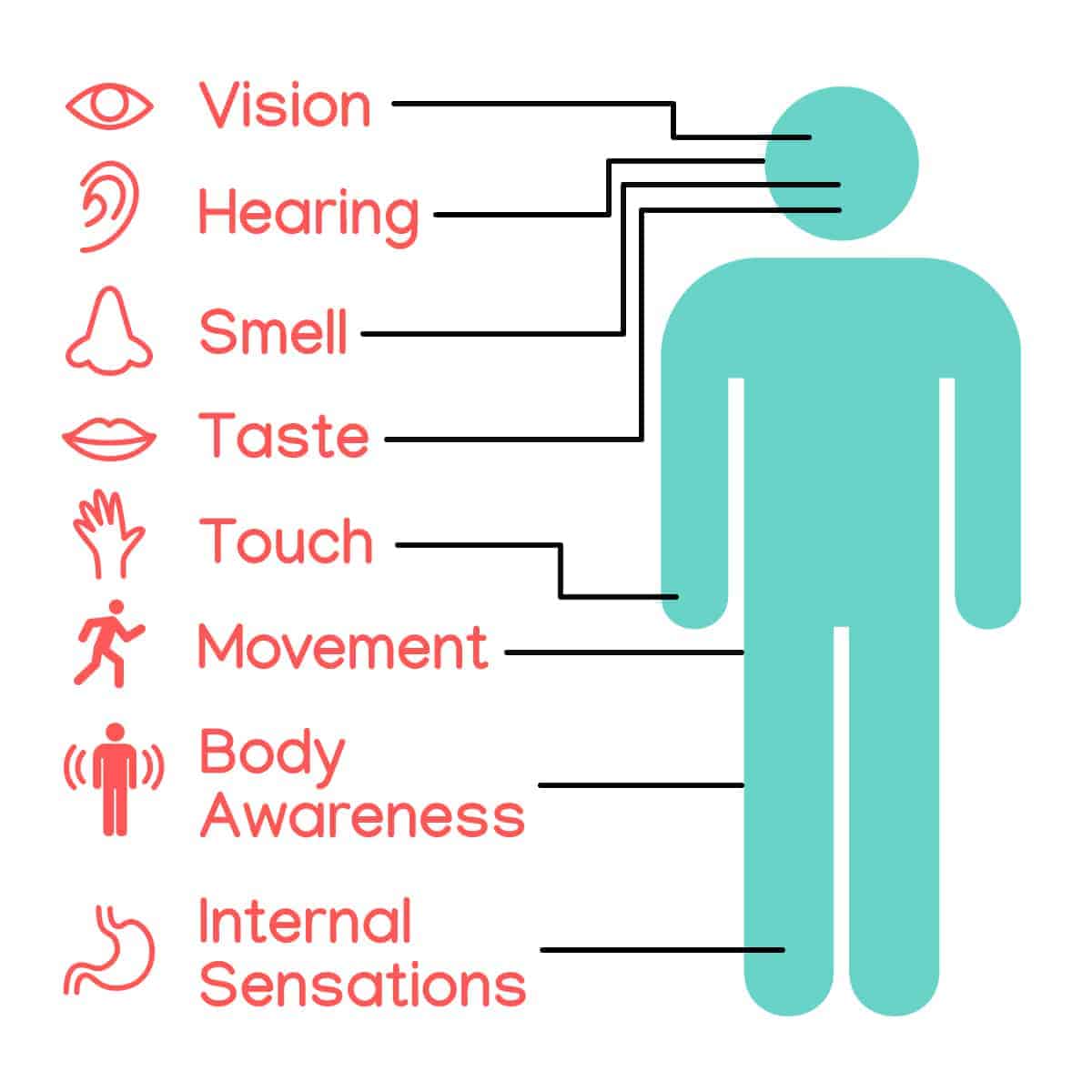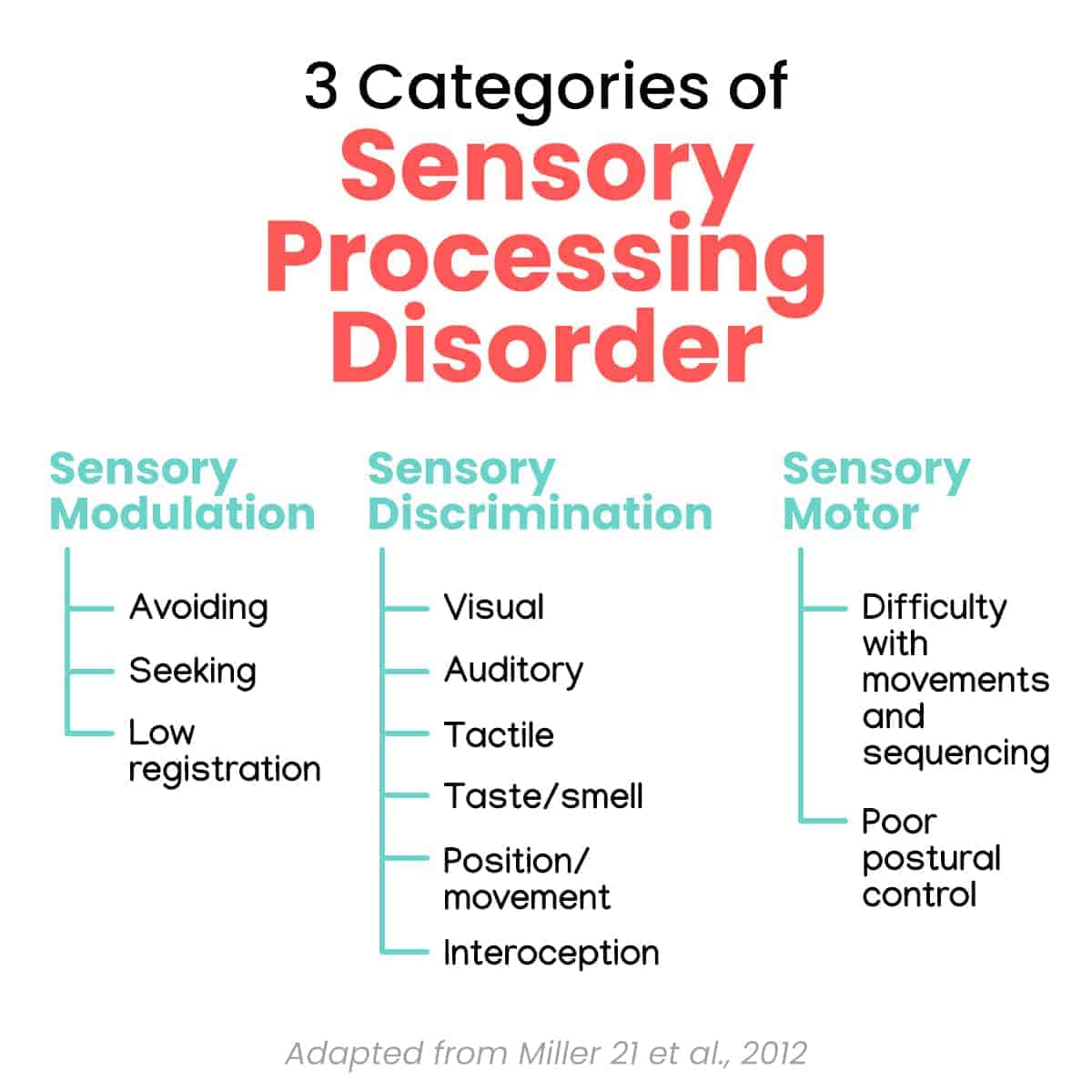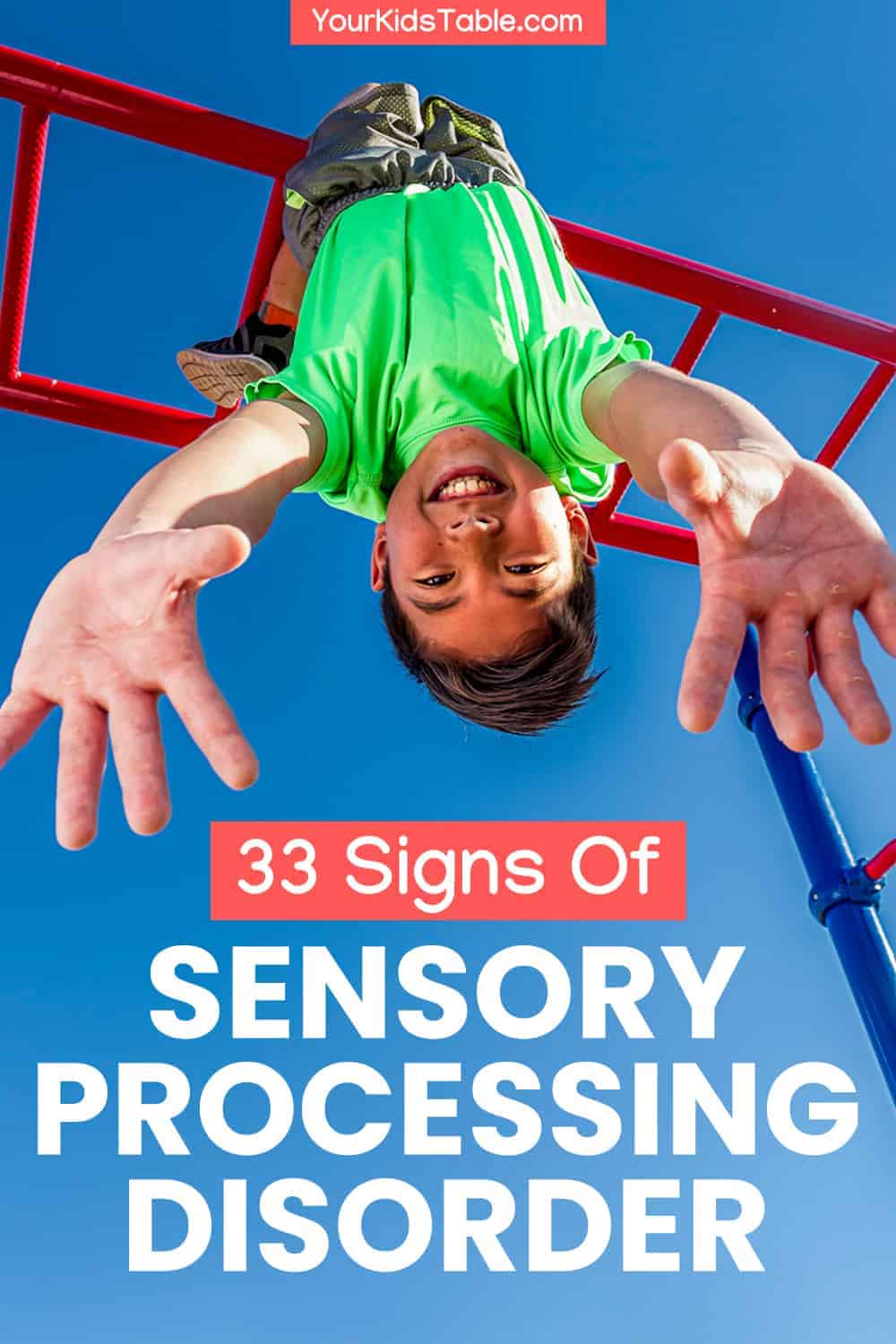Learn the important symptoms and signs of sensory processing disorder in toddlers and children from an occupational therapist, and how to get a diagnosis and treatment options for SPD.
Since most parents are never told about sensory processing difficulties, they’re often confused when they see their child acting or responding differently than other children…
They may think their child’s behaviors are a little unusual, or quirky.
Or, feel frustrated because typical parenting strategies don’t seem to work with their child.
Or, their anxiety may skyrocket as they watch their sensitive child struggle to navigate the world around them.
But, there’s a very good reason that a child might have quirky, difficult, wild, or sensitive behaviors. They all lead to difficulties in sensory processing. Those challenges vary from child to child and can be mild, moderate, or severe.
Kids that fall into the moderate to severe range of sensory issues might have Sensory Processing Disorder.
What is Sensory Processing Disorder?
Sensory Processing Disorder (SPD) is a neurological disorder that causes impaired processing of sensory input.
Let me put that into everyday language. First, a neurological disorder means that a child cannot control the difficulties the disorder causes, although with SPD sensory processing can be improved.
Second, impaired processing means that the brain isn’t receiving or responding to the different sensations it’s constantly bombarded with as we typically see in most children.
Third, sensory input is any sensation that a child experiences from the 8 senses:

- Touch (Tactile)
- Smell (Olfactory)
- Vision (Sight)
- Hearing (Auditory)
- Taste (Gustatory)
- Body Awareness (Proprioception)
- Movement (Vestibular)
- Signals from internal organs such as hunger, bowel movements, and emotions (Interoception)
Any combination or ALL of these senses can have delays or be impaired. When they are, we see kids acting in unusual, quirky, or frustrating ways.
That means that SPD occurs when the brain is mismanaging all the sensations it receives which causes disruptions in their life in all sorts of ways from difficulty paying attention to refusing to wear certain types of clothing.
SPD Isn’t Always Recognized as a Diagnosis
While SPD is recognized by a wide range of organizations and institutions including The American Academy of Family Physicians, it is not in the Diagnostic Statistical Manual of Mental Disorders (DSM-5) or ICD-10 codes, which are needed for an official diagnosis and insurance billing.
This is true in the United States, the UK, Canada, and Australia.
However, specially trained occupational therapists can evaluate for and provide the unofficial diagnosis when appropriate.
As an occupational therapist, my hope is that SPD does become an official diagnosis because it will create the much needed awareness for the high prevalence of children that are struggling with sensory issues, which is around an estimated 5-14% of children.
But, as a practitioner, and as a mom, the diagnosis doesn’t change how to help kids overcome and manage the symptoms of sensory processing disorder.
What Causes Sensory Processing Disorder?
We need more research for the causes of sensory processing disorder. But, some research and theories point to these risk factors:
- Premature birth – The sensory system isn’t fully developed until the final weeks of gestation. When babies are born earlier than expected, it’s common to see that they have difficulties processing sensory information.
- Genetic link – I’ve worked with so many children and families that tell me a parent has struggled with the same sensory issues as their child. It seems that there’s a hereditary component to the diagnosis for some, but not for all children with the diagnosis.
- Extreme sensory deprivation early in life – Some studies have shown that babies that are neglected from touch, cuddling, and holding in the first months of life have sensory systems that don’t develop as we’d typically expect.
Others wonder if environmental toxins play a role, but again, we don’t have clear data. And, we also know that drug and alcohol exposure have a much higher likely of having SPD.
It’s also important to note that many kids with ADHD (40% estimated) also have the additional diagnosis of SPD.
And, children with Autism Spectrum Disorder (ASD) often have signs of sensory processing disorder too, as many as 75%. There is also high prevalence of children with anxiety disorders also experiencing sensory issues. However, sensory processing disorder is a stand alone disorder so children that have SPD don’t necessarily have autism, an anxiety disorder, or ADHD.
3 Categories of Sensory Processing Disorder
The sensory system is complex and Sensory Processing Disorder actually has 3 different patterns or categories that occupational therapists use when giving the diagnosis:
1. Sensory modulation disorder – The brain is having difficulty taking in the the information and deciding if and how it will respond. This is the most common type of Sensory Processing Disorder.
2. Sensory discrimination disorder – The brain is unable to clearly discriminate between sensations. For example, it may be difficult to tell the difference between a quarter and penny in your pocket without looking or perceiving a light touch versus a firm touch when somebody brushes past you.
3. Sensory based motor disorder – The brain has difficulty sequencing steps and following directions or isn’t sending adequate sensory messages to the core for muscle strength and control, resulting in slouching and fatigue. You’ll likely see kids struggling with following the regular routine of getting dressed, mixing up the steps that have this type of SPD. Or, a child may struggle in school because they can’t sit up at their desk for long periods.
A child can have just one of the categories or patterns of sensory processing disorder, or all 3, as it’s been defined by the work of occupational therapist Lucy Jane Miller.

What are the Signs of Sensory Processing Disorder
Sensory modulation is the most common form of sensory processing disorder, it also has three subtypes (see the above flow chart) and again a child can have a combination of them. For instance, your child may hate loud noises and bright lights which is a sensory sensitivity. But, they may also have a hard time sitting still and crave lots of movement, which are signs of sensory seeking.
Let’s dive into the most common signs of sensory processing disorder…
Overprocessing Sensory Input: Sensory Sensitivity Signs
A child’s brain that is overprocessing input is literally over responding to the sensation it is receiving. Another way to say this is that a child is hypersensitive to certain senses or all 8 of them.
It’s as if the brain is working over time. When a child is overprocessing sensory input, you may see these signs:
- Afraid of loud noises like automatic hand dryers in a public bathroom, a firetruck driving down the street, or the vacuum cleaner
- Sensitive to different types of clothing, tags or seams in clothing, making dressing difficult
- Sensitive to different tastes or textures of foods that may result in them only eating a handful of foods
- Sensitive to smells and may complain of a variety of smells that others don’t even notice
- Sensitive to bright lights in any environment, but may struggle in stores where there’s lots of overhead fluorescent lighting
- Hates to get their hands messy or walk bare foot in the grass
- Scared of riding swings, roughhouse play, or going down a slide
- Avoids new situations and is overwhelmed in crowds
- Afraid of being bumped into or touched by others
Children that experience hypersensitivity are also likely to reach sensory overload more quickly and experience sensory meltdowns.
Craving Sensory Input: Sensory Seeking Signs
Children are wired to have sensory experiences in their daily life, but children with this type of sensory modulation difficulty constantly seek out more sensations, often never seeming to get enough.
When a child is seeking sensations, they can become wilder as their sensory system gets more disorganized. In this case, you may see these symptoms of sensory processing disorder:
- Runs, climbs, or crashes into things all the time
- Plays very rough with other children
- Never seems to get tired and has a hard time falling asleep
- Hits, bites, or pushes for seemingly no reason at times
- Loves crunchy, sour, spicy, salty, or other strongly flavored or textured foods
- Spins or hangs upside down all the time
- Never seems to get dizzy
- Touches everything and sometimes other people
- Has a hard time sitting still and attending
- Has a difficult time following directions
- Chews on their shirt, pencils, or objects in their environment
Underprocessing Sensory Input: Low Registration Signs
This third category, is the least common, but it’s possible that a child with sensory processing disorder may have low registration of sensory input. When a child underprocesses sensory information in the brain, it’s like the sensation is mild or vague. The sensations aren’t registering, or have low registration in the brain.
When a child has sensory processing disorder with low registration, you may see the following signs:
- Constantly lethargic
- Unmotivated to get off the couch and do much of anything
- Difficulty paying attention in class or learning
- Doesn’t notice loud sounds readily
- May have to touch them to get their attention before speaking to them
- Doesn’t notice tastes or textures of food unless they’re very bold
- Often clumsy and doesn’t seem to know where their body is as they move around
- Very high pain tolerance
- Doesn’t notice food on face
It’s possible for kids to have a combination of these subtypes of sensory processing disorder. Head to our post on sensory red flags for more signs that are easy to miss!
Can My Child Have Sensory Issues Without a SPD Diagnosis?
As you look through the symptoms of SPD above, it’s important to know that occupational therapists that give the diagnosis are looking for:
- A child to be experiencing a significant amount of these symptoms
- An impact on their daily life that affects their ability to socialize, learn, sleep, eat, follow directions, fine motor skills, and maneuver through their environment efficiently for their age.
That means that there are A LOT of kids, including my own sons, who have sensory issues but don’t need a sensory processing disorder diagnosis. However, they still benefit from sensory strategies like using beneficial sensory activities or a sensory diet.
What Age Do Kids Usually Develop Sensory Processing Disorder?
It’s possible to see sensory processing disorder signs from birth as some babies will cry when bounced, swayed, or are swaddled. For some babies, those symptoms will disappear, for others, they’ll continue and accumulate into the toddler years.
For many children, signs of sensory issues aren’t obvious until 2 or 3 years old.
The American Occupational Therapy Association (AOTA) suggest that children 0-3 with signs of sensory processing disorder be screened by an occupational therapist. Children age 4 and up can participate in a thorough evaluation at a clinic called the Sensory Integration Praxis Test (SIPT).
It’s a long and thorough evaluation in which the occupational therapist has the child complete certain tasks and they observe their responses and movements.
The SIPT can be very expensive, check with your insurance company for coverage and those qualified in your area to administer the evaluation.
Sensory Processing Disorder Treatment Options
Sensory integration therapy is the gold standard for treatment of sensory processing disorder, which is completed by occupational therapists with advanced training in this treatment approach.
The sensory diet, or specialized sensory activities are extremely beneficial in the home environment and children can experience an improvement in their sensory processing difficulties with either or both options.
Sensory Integration therapy is particularly recommended when sensory processing disorder is severely impacting a child’s behavior and their ability to socialize, learn, and use age appropriate motor skills.
Free Help for Kids with Sensory Issues!
Unfortunately, treatment options may include some barriers. Sensory integration may not be an option for you because of your location or financial situation. And, putting together a sensory diet or using the most helpful sensory activities can be confusing and overwhelming.
The most important part of our mission here at Your Kid’s Table is to support you and make the expert knowledge of OT’s accessible to parents.
That’s just what we’re doing with our Free Sensory Workshop to help you support your child’s sensory issues, no matter how big or small, at home easily. Without all the overwhelm.
More about Signs of Sensory Processing Disorder
3 Ways to Figure Out if Your Kid Has Sensory Over or Under Processing
What Parents Need to Know About Sensory Dysregulation
What If Your Kid Isn’t Listening Because of Auditory Processing Difficulties?
Top 10 Sensory Swings for Kid’s Development and Sensory Processing
Help us create awareness about sensory issues! Pin this to Pinterest or share on facebook!
Alisha Grogan is a licensed occupational therapist and founder of Your Kid’s Table. She has over 19 years experience with expertise in sensory processing and feeding development in babies, toddlers, and children. Alisha also has 3 boys of her own at home. Learn more about her here.

Thank you for this informative post! It really opened my eyes to the signs of sensory processing disorder. I had no idea how many different ways it could manifest in children. I’ll definitely be keeping an eye out for these signs in my own kids.
Hello, my little one pushes his body and feet and chin on or into me all the time. He is a very fussy eater sensitive to texture. His is clumsy and could be described as lazy. It seems he has a mixture of sensory seeking and sensory avoiding.Is that possible with SPD? Or is it only one way or the other?
Thank you for this insightful post! As a parent, it’s been a challenge to understand my child’s behaviors, and your breakdown of the signs of Sensory Processing Disorder really resonates with our experiences. I appreciate the practical tips you’ve included—it’s so helpful to know what to look for and how to support my child better.
Hi there,
So glad you found this information helpful. Thanks for following along and for the kind words!
Best,
Laura
Your Kid’s Table team member
I found your article very informative and full of interesting information. My son
Has many sensory issues such as, he
Only eats certain foods, & bright lights really bother him. He also is bothered by various textures & materials. He has come a long way from years ago. He is now a 32 yr old man, highly intelligent, with an amazing memory. I have searched for years for various forms of help for him. Many social workers, therapist & Doctors. I have yet to find a
Good Sensory professional in the St. Louis area. Please, forward any information that you think could help him. I thank you in advance and for sharing all of the valuable information.
Hi Beverly, thank you so much for the feedback, and thank you for reading! It is true, there are fewer resources for adults with sensory sensitivities, but fortunately more and more are becoming available due to adults putting out information that they wished they had both as kids and into adulthood. It sounds like you’ve been and continue to be a valuable advocate for your son. If you haven’t, check out our guest post an adult with Autism wrote. She has valuable insight into adults with sensory needs.
Best,
Laura, Your Kid’s Table team member
HI I am a SLP w Birth 23 and love to have a copy of this article. So many children being evaluated….are they on the autism spectrum or ADHD w SPD? Also, do you have a book or one you could recommend?
thanks so much for your time!!
Nancy
Pls email article if available
Hi Nancy! Thanks so much for reaching out and sharing your feedback! So glad to hear that you found this post helpful! Unfortunately, we do not offer this post in PDF form, but if you’d like to pass along the info, you can share the link (https://yourkidstable.com/signs-of-sensory-processing-disorder/)! Hope that helps!
Best,
Kalyn
Can you send me a PDF version that I can copy? This is excellent info.
Hi Laurie! Thanks so much for reaching out and sharing your feedback! So glad to hear that you found this post helpful! Unfortunately, we do not offer this post in PDF form, but if you’d like to pass along the info, you can share the link (https://yourkidstable.com/signs-of-sensory-processing-disorder/)! Hope that helps!
Best,
Kalyn
This is a great article! I wish I knew all of this when my child was much younger (he is 35). Doctors, teachers, family, and friends all thought my child was overreacting or doing it for attention. We are still dealing with sensory issues and finding coping skills! Thanks for all you do in spreading the message!
Hi Beccy! Thanks for reaching out and sharing your feedback! We are so glad you found this post helpful. And we agree- there’s so much more information now than there was years ago! Our goal is to spread awareness and help provide all the tools needed to help those with sensory needs 🙂
Best,
Kalyn
Thank you very much! This is a wonderful summary and so easy to read and understand.
Hi Paula! Thank you so much for sharing your thoughts and feedback with us! So glad you enjoyed this post and found it helpful. And it’s great to know that it was easy to read and understand!
Best,
Kalyn